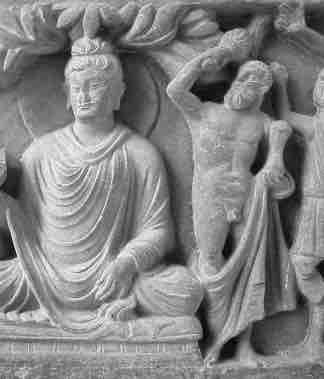Overview: Gandhāra and Mathura
In ancient art, anthropomorphic representations of the Buddha started to emerge from the 1st century CE in Northern India. The two main centers of creation have been identified as Gandhāra in today's North West Frontier Province in Pakistan, and the region of Mathura in central northern India.
Gandhāran Art
Introduction
Gandhāra is the name of an ancient kingdom located in parts of modern-day northern Pakistan and eastern Afghanistan, mainly in the Peshawar Valley, the Pothohar Plateau, and the Kabul River Valley. The Kingdom of Gandhāra lasted from the early first millennium BCE to the 11th century CE. The art style of the Kingdom flourished and achieved its peak during the Kushan period, from the 1st to the 5th centuries; it then declined and suffered destruction after the invasion of the White Huns in the 5th century.
Style
Gandhāra is noted for its distinctive style of Buddhist art, which developed out of a merger of Greek, Syrian, Persian, and Indian artistic influences. This development began during the Parthian Period (50 BCE–CE 75). The art of Gandhāra benefited from centuries of interaction with Greek culture after the conquests of Alexander the Great in 332 BCE and the subsequent establishment of the Greco-Bactrian and Indo-Greek Kingdoms, leading to the development of Greco-Buddhist art.
In Gandhāran art, the Buddha is often shown under the protection of the Greek god Herakles, standing with his club (and later a diamond rod) resting over his arm. This unusual representation of Herakles is the same as the one on the back of Demetrius's coins, and it is exclusively associated to him (and his son Euthydemus II), seen only on the back of his coins. Gandhāran Buddhist sculpture displays Greek artistic influence, and it has been suggested that the concept of the "man-god" was essentially inspired by Greek mythological culture. Artistically, the Gandhāran School of sculpture is said to have contributed wavy hair, drapery covering both shoulders, shoes, sandals, and acanthus leaf decorations.

Buddha Herakles
The Buddha and Vajrapani under the guise of Herakles.
Stucco as stone was widely used by sculptors in Gandhāra for the decoration of monastic and cult buildings. Stucco provided the artist with a medium of great plasticity, enabling a high degree of expressiveness to be given to the sculpture. Sculpting in stucco was popular wherever Buddhism spread from Gandhāra: India, Afghanistan, Central Asia, and China.
Mathura Style
Introduction
Mathura is a city in the North Indian state of Uttar Pradesh. The art of Mathura tends to be based on a strong Indian tradition, exemplified by the anthropomorphic representation of divinities such as the Yaksas, although in a style rather archaic compared to the later representations of the Buddha. The Mathuran school contributed to many new styles in art such as clothes covering the left shoulder of thin muslin, the wheel on the palm, and the lotus seat.
Art of Mathura
The representations of the Buddha in Mathura are generally dated slightly later than those of Gandhāra (although not without debate) and are also much less numerous. Mathura sculptures incorporate many Hellenistic elements, such as general idealistic realism, and key design elements, such as curly hair and folded garments. Specific Mathuran adaptations tend to reflect warmer climatic conditions, as they consist in a higher fluidity of the clothing, which progressively tend to cover only one shoulder instead of both. The art of Mathura also features frequent sexual imagery: female images with bare breasts or nude below the waist, displaying labia and female genitalia, are common, making these images more sexually explicit than those of earlier or later periods.
Mathura Buddha
A Bodhisattva, 2nd century, Mathura.
Relationship to Gandhāra Style
The Mathura and Gandhāra styles strongly influenced each other. During their artistic florescence, the two regions were united politically under the Kushans, both being capitals of the empire. It is still a matter of debate whether the anthropomorphic representations of Buddha were essentially a result of a local evolution of Buddhist art at Mathura, or a consequence of Greek cultural influence in Gandhāra through the Greco-Buddhist syncretism. This iconic art was characterized from the start by a realistic idealism, combining realistic human features, proportions, attitudes, and attributes, together with a sense of perfection and serenity reaching to the divine. This expression of the Buddha as both man and God became the iconographic canon for subsequent Buddhist art.
Influences and Legacy
Hindu art began to develop from the 1st to the 2nd century CE and found its first inspiration in the Buddhist art of Mathura. It progressively incorporated a profusion of original Hindu stylistic and symbolic elements, in contrast with the general balance and simplicity of Buddhist art. The art of Mathura acquired progressively more Indian elements and reached a very high sophistication during the Gupta Empire between the 4th and the 6th century CE. The art of the Gupta is considered as the pinnacle of Indian Buddhist art.
Gupta Buddha
Buddha from the Gupta period, Musée Guimet, Paris. Personal photograph, 2004.